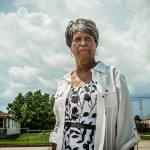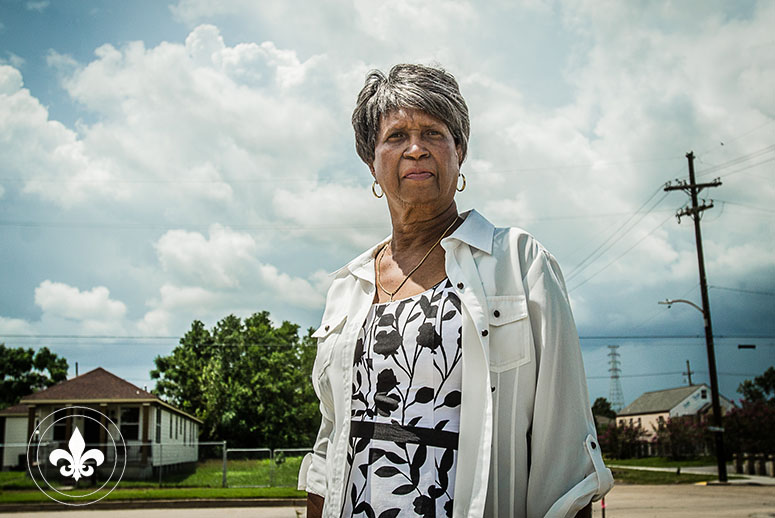
This piece was originally published on TakePart.com Betty Bell, 73, has waited more than a decade to rebuild her home in New Orleans’ Lower Ninth Ward neighborhood. (Photo: Pableaux Johnson) On a humid afternoon in late July, Leslie Johnson, a 50-year-old medical assistant, stands under a crepe myrtle tree in front of her home in the Lower Ninth Ward neighborhood. There are few other houses on the block, which once teemed with families, and children. That was before Hurricane Katrina, when the neighborhood felt like a village. “We knew everybody, and everybody knew us,” Johnson says, wiping sweat off her plump cheeks. Hurricane …
This piece was originally published on TakePart.com

Betty Bell, 73, has waited more than a decade to rebuild her home in New Orleans’ Lower Ninth Ward neighborhood. (Photo: Pableaux Johnson)
On a humid afternoon in late July, Leslie Johnson, a 50-year-old medical assistant, stands under a crepe myrtle tree in front of her home in the Lower Ninth Ward neighborhood. There are few other houses on the block, which once teemed with families, and children. That was before Hurricane Katrina, when the neighborhood felt like a village. “We knew everybody, and everybody knew us,” Johnson says, wiping sweat off her plump cheeks.
Hurricane Katrina was one of the worst catastrophes in American history, and no neighborhood was more affected than the Lower Ninth Ward. Many of the people whose families owned homes here for generations haven’t returned–partly because they can’t afford to, or because they’ve settled in Houston, Atlanta, and points in between. “It’s sad,” Johnson tells me.
In the last decade, much of New Orleans has been recovering at an astonishing pace. Billions of government and philanthropic dollars have been pumped into the recovery, and the city has been called a boomtown, for good reason. Construction clogs the streets. Nearly $2 billion is being spent on new schools. Downtown office buildings that largely sat empty for decades are being turned into condos for the newly moneyed young–a dramatic shift for a city that for much of the last half-century exported talent. Rents are soaring. Now, New Orleans is one of America’s fastest-growing cities–and the envy of places like Detroit. All of this helps explain why last spring, the mayor, Mitch Landrieu, declared: “Nearly 10 years after Katrina, we are no longer recovering, no longer rebuilding. Now, we are creating.”
If you never left downtown New Orleans, you’d be forgiven for believing the hype. Yes, New Orleans has bounced back, and has never been better–if you’re young, college-educated, relatively wealthy, and white. But if you’re black, low-income, or middle-class–whatever that means, these days–you might be blocked from the new prosperity. There’s another side to the post-Katrina story, and it’s one of severe inequality. New Orleans’ black population has declined by nearly 100,000 since Katrina. The share of white households considered middle or upper class is growing–and black poverty is expanding. Forty-four percent of black households in New Orleans earn less than $21,000. The truth is, for black people with roots in this city, the recovery isn’t complete. And many of us are asking ourselves: What is the place for black people in post-Katrina New Orleans?
The Katrina story isn’t an academic exercise. It’s deeply personal. I was born in New Orleans, and grew up here. Members of my family have lived in the Lower Ninth Ward for at least four generations. Growing up in the late 1980s and early ’90s required extraordinary discipline, especially for black kids. Driving each morning to schools across town, we were wired to ignore the craziness outside our window. It was a survival mechanism, a way to stay focused on one goal: success.
There was no doubt that I’d leave New Orleans. It wasn’t a boomtown. In the summer of 1995, my mom and dad packed their car and drove me to Howard University. The rest of the story basically goes like this: I studied journalism, landed jobs in Washington, then Chicago, then Detroit, and then New York. Never expected to move back to New Orleans. I visited relatives a couple times a year. Still, I felt rootless.
Then came August 2005. The news warned of a powerful storm approaching from the Gulf of Mexico. Usually, most New Orleanians ignored such warnings and stayed in their homes. But this time, my mom recalls God telling her to leave. And so she, my dad, and my younger brother drove to Selma, Alabama, to stay with relatives. They expected to be there a couple days. But, of course, there was the flood. I watched it unfold from my post at The Wall Street Journal’s Chicago bureau. Katrina wasn’t, at that time, the kind of story the Journal typically covered. Nevertheless, I pitched my boss on an idea: Send me to New Orleans to write about people who saw the storm as a chance to escape poverty. Soon, I was on a plane to Memphis, Tennessee, because flights to Baton Rouge, Louisiana, and Jackson, Mississippi, were booked. I rented an SUV and went to a store to buy bread, peanut butter, and jelly. I drove to New Orleans, not knowing what to expect.
Days after the levees failed, the city was silent. There were plumes of smoke: Something was burning along the Mississippi River. Finally, I talked my way past National Guard troops and got to my parents’ neighborhood. The streets were covered in a thick green mud. I found our house. The door had been popped open and marked with a giant X, spray-painted in orange, partly to signal that the house had been checked for bodies. I walked into the front room, and the family picture we’d taken in the mid-1980s was still there. I pulled it off the wall and brought it to my SUV. Then, I quickly left. I was moving so quickly, heading back to a reporting assignment, there was no time to stop and process what I’d just seen.
My family was committed to rebuilding. By November 2005, they’d returned to New Orleans. Like so many people who lost everything, they briefly lived in a federal government-issued trailer. Because our house stood in 10 feet of water, it was structurally unsound, and was eventually demolished. By July 2010, my parents had moved into a new house. Some good things had come out of Katrina. “It was an opportunity to start from scratch,” my mom says, “and I built the house of my dreams.” It is, of course, impossible to forget what’s been lost: The people who never returned. The people who died.
Only recently had I begun to process all that’s happened in the last decade, mainly because I’ve been busy working. My folks rarely discussed the details of what they endured. There’s some guilt about not being more fully engaged in the city’s recovery. That’s partly why I had to come back, to bear witness, and come to terms with my city.
In late July, I found myself driving through some of New Orleans’ historically black neighborhoods–New Orleans East, Gentillly, and the Lower Ninth Ward. Ten years ago, I rode in a police boat down Read Boulevard. Our boat bounced against the tops of submerged cars. We saw one or two bloated bodies floating. Now, it’s amazing how much the neighborhoods had been transformed–and what their stories say about the different New Orleans recoveries.
Gretchen Bradford is carefully tracking the progress. Since the 1950s, her Pontchartrain Park neighborhood had been home to many black professionals. And before Katrina, there were roughly 1,200 residents. Now, there are barely 800. Bradford, who is president of the Pontchartrain Park Neighborhood Association, is happy about the new school and restored golf course. She’s concerned about the influx of renters. “When you don’t know who your neighbor is,” she says, “crime can go up.” But she’s grateful to be back home–and in a stable community.
Not everyone is so lucky. Take Betty Bell. In the 1960s, Bell’s parents bought a plot of land in the Lower Ninth Ward and built a 2,000-square-foot house. Eventually, Bell turned the house into a double–living on one side with her children, renting the other for about $700 a month. For nearly 25 years, Bell worked for the state of Louisiana, and she bought a second house two hours’ drive to the north, in Mississippi. When Bell retired, she lived between both residences. “I was comfortable,” the 73-year-old recalls.
Her New Orleans house stood blocks from the Industrial Canal’s levees, which breached during Katrina’s storm surge. For nearly a month, the house was underwater. “It made you go through all kinds of emotions,” she says. The house was destroyed, and the city tore it down. She fumed as officials talked openly of turning parts of the Lower Ninth Ward into green space.
So she stayed in Mississippi, and entered the Road Home program, an $11 billion federal government initiative designed to help the Katrina diaspora’s homeowners return and rebuild. The government used the pre-storm value of a home to calculate how much aid should be issued. Generally, homeowners could receive up to $150,000, and there was one key condition: If you took the government money, you had to rebuild the house.
But there was a troubling pattern. Counselors at the Greater New Orleans Fair Housing Action Center noticed that many of their African American clients received smaller grants than white clients from neighborhoods where homes were appraised at a higher value–even when the homes had similar square footage, had sustained comparable damages, and were estimated to need the same amount of money to repair. Many homes in places like the Lower Ninth Ward hadn’t been appraised in years. Your home may have been valued at $50,000, and it would take $150,000 to rebuild. But you’d have to find a way to make up the $100,000 difference. “The lack of ability to fill that large gap played a part in whether homeowners were able to return to their homes,” Cashauna Hill, head of the Greater New Orleans Fair Housing Action Center, says.
In the Lower Ninth Ward, some people were able to live below the federal poverty line because they owned their homes outright–often, because they’d been passed down across generations–and didn’t have to pay 40 percent of their income on rent. They had a reasonable standard of living, even if they had little or no savings.
Bell found the Lower Ninth Ward Homeownership Association, which helped her navigate the onerous Road Home program. Bell’s initial Road Home grant wasn’t enough to cover her estimated rebuilding costs. So she fought. In the meantime, she used the money for housing, food, and medicine for her cancer and diabetes. By 2011, the federal government had reached a $62 million settlement in a lawsuit that alleged the Road Home program made it difficult for black homeowners to return to New Orleans. Earlier this year, Bell was awarded roughly $100,000, and she will soon begin rebuilding an 800-square-foot home in the Lower Ninth Ward. “It’s small,” she says, “but at least it’s mine.” She plans to return to New Orleans–most of her doctors are here–and live in the house full-time.
There’s little doubt in Bell’s mind about why it’s taken so long to rebuild. “The government was sitting on that money, hoping the black folks wouldn’t come back,” she says. She’s skeptically watching city officials fix neighborhoods as the Katrina anniversary approaches and steer reporters to some of the Lower Ninth Ward’s success stories–like a gleaming new community center. “If they made a left-hand turn and go where I lived, where all those people drowned,” she says, “they’ll see a whole different story.” In a week or two, when the cameras leave, life here will probably return to normal. She knows the city will probably stop cutting grass as frequently in the Lower Ninth Ward. The police may not roam as frequently. Organizations will still be rebuilding–because there’s so much work to do, so many people who still want to come home.
Betty Bell’s story is exceptional, and that’s unfortunate. There are thousands of black citizens who want to return to New Orleans, but can’t–partly because there’s an affordable housing shortage. It doesn’t help that four of the city’s public housing developments have been demolished since Katrina. There’s talk of “mixed-income” housing, but who knows how that will work out. It’s not hard to connect the dots between the housing problem and deepening poverty to conclude that black people have been abandoned in New Orleans’ recovery. That’s dangerous–and a recipe for widening inequality. The city’s recovery won’t be successful until everyone has a chance to return home–and live the American dream.
Yes, New Orleans should be prosperous, and diverse. But not if it means New Orleans becomes a city that black people can’t afford to live in. So we must continue to bring services and infrastructure to places like the Lower Ninth Ward. We can’t afford to lose communities that have played such a key role in our city’s development. New Orleans–and our country–are at a critical moment. And we have to get this right.
Visit TakePart.com for more on Project Katrina.
— This feed and its contents are the property of The Huffington Post, and use is subject to our terms. It may be used for personal consumption, but may not be distributed on a website.
Read this article:
What Is the Place for Black People in Post-Katrina New Orleans?

























